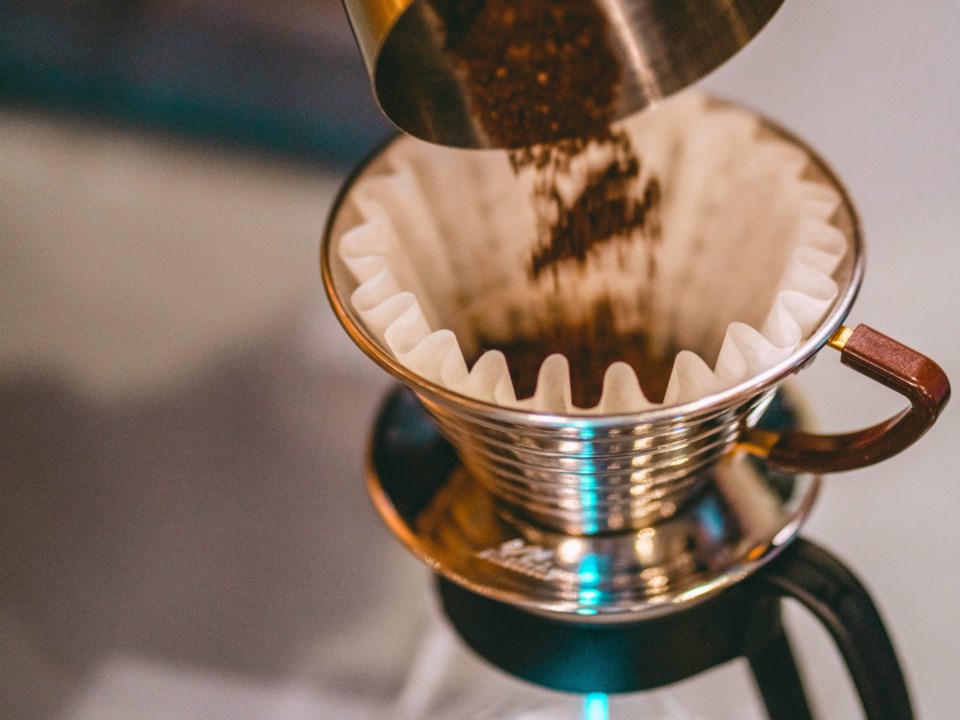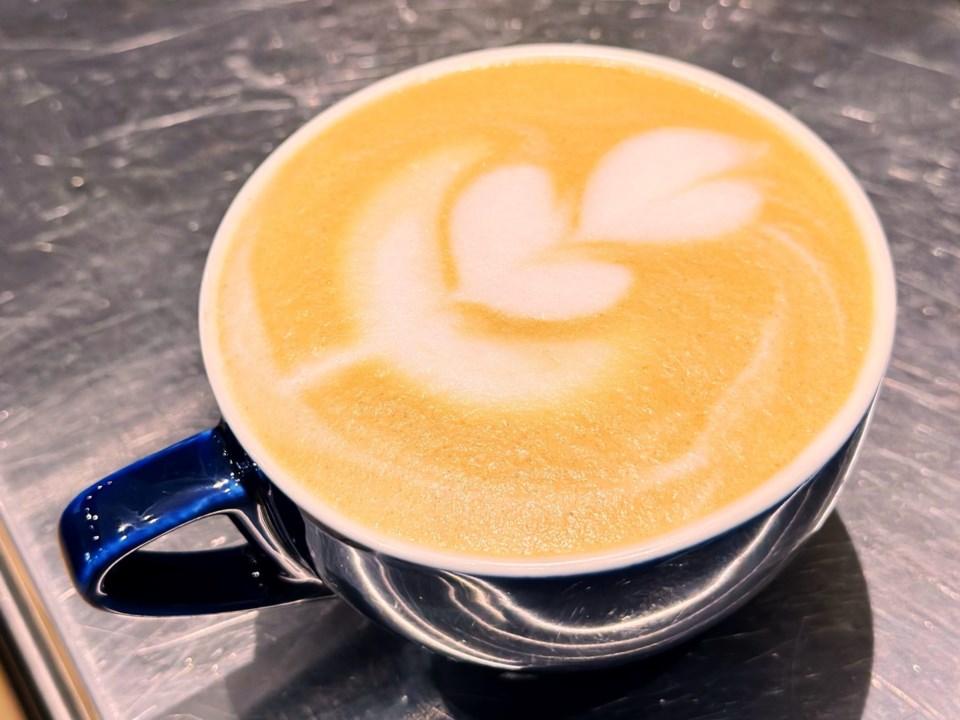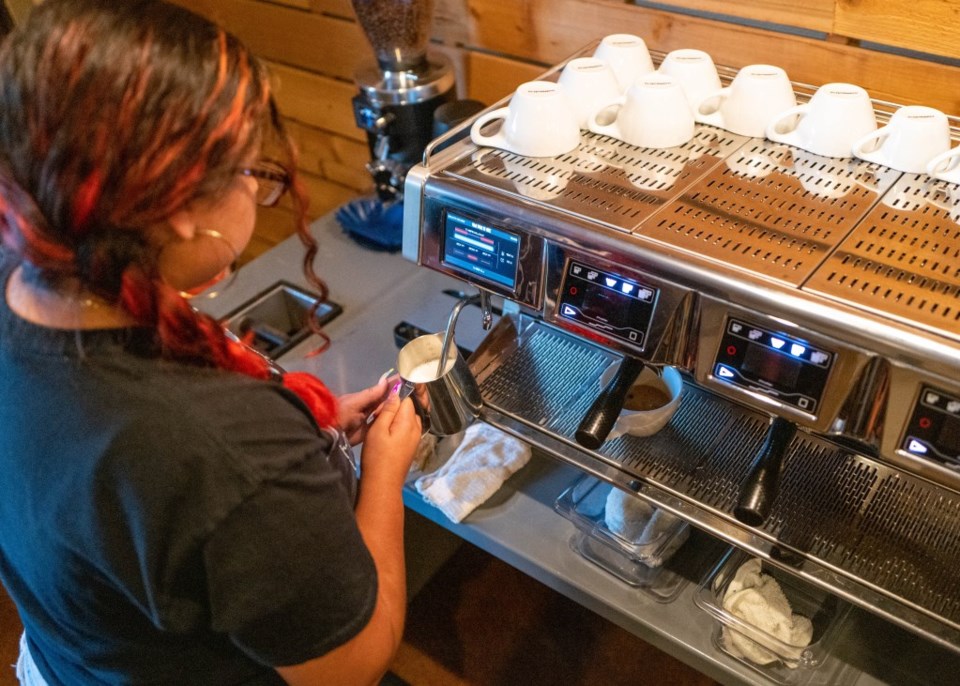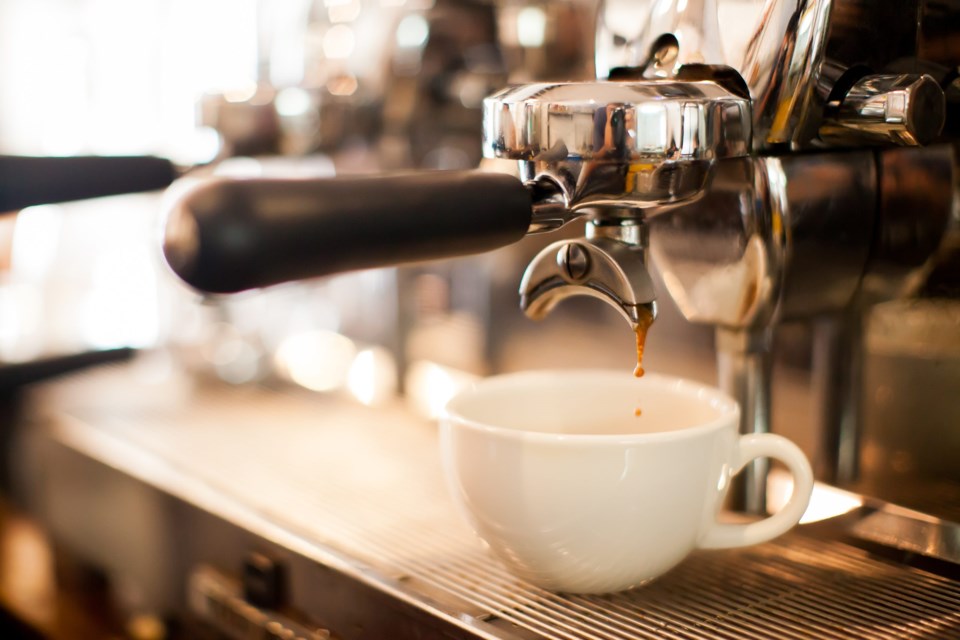Coffee begins my day every morning. I used to live in a K-cup world, simply throwing in a pod and pressing a button, but for me, that brew is no longer satisfying. I’m on a quest. I want to make the perfect cup of coffee — or pretty darn close to it. For me, the perfect cup is the opportunity to try new things and love every sip. But I haven’t figured out what my perfect cup is … Yet.
Collin County is home to many coffee shops, which make some of the best coffee I have ever tasted. I hoped to find inspiration and learn how to better my own skills.

In the Beginning, There Were Beans
The exterior of Toasted Coffee + Kitchen Plano, black and white with bright blue finishes, suits their bold coffee and fun flavors. Owner Bob Sinnott tells me about the adventures of becoming a business owner during what he calls a “mid-life crisis.” His past in the customer service industry mostly involved behind-the-scenes management, but he wanted more. He sips an iced tea and explains that he is not the coffee expert, but the manager of Toasted Plano, Ethan Levy, sure is. Levy, a five-year vet of the coffee scene, moves around the shop like he could do it with his eyes closed. He works the espresso machine like it’s an instrument. Every movement looks choreographed, memorized and precise. Sinnott did not exaggerate Levy’s coffee-making skills — I can taste it. Like mine, Levy’s passion for coffee stems from taking that first morning-sip.
According to Levy, the trick to finding the right cup of coffee starts with the bean. He prefers a medium roast. “I believe that a medium roast makes for the best espresso, and if you’re using at-home drip coffee, I suggest a darker roast to get a fuller flavor to your regular cup of coffee,” he says. For Levy, single-origin Ethiopian or Guatemalan roasts are a good place to start, as well as his personal favorites. He recommends buying small batches of different types and continuing to try until you find one that you most enjoy. “Look at the flavor hints in the beans you buy and get roasts that have flavor hints that you know that you will personally enjoy,” he says. I’m also a big fan of Ethiopian single-origin beans. The country’s coffee, shipped and traded for hundreds of years, has a deep aroma that is almost winelike. Some say Ethiopia is the home of coffee, and legend dates the country’s coffee history from 600 AD.
But the bean must be processed. There are three main ways to do this: washed processing, natural (or dry) processing and honey processing. In the washed, or wet processing method, the bean is dried without the skin of the plant, also known as the cherry. After a de-pulping process, the bean is fermented and then washed before drying. The dry method is known to be more old school: the beans are dried without the removal of fruit or cleansing. In the honey processing method, which is not as common, a sticky coating that oxidizes and darkens forms as the bean dries.
Levy enjoys a washed process coffee best — so do I. The aroma of the freshly brewed coffee is deep and strong, but on the palate, there is a smooth and velvety taste. The washed process is complicated and includes a fermentation step, so unless you live where coffee beans are grown, you can find a prewashed batch in shops. Toasted is known for its sweet coffee concoctions, but the sweet taste can also come from the beans. Often, washed coffees leave notes of cane sugar and even chocolate. Whatever the process, store your beans in the freezer to extend their shelf life and keep the beans as fresh as possible.
Those processed beans need to be turned into coffee grounds. If you grind your own beans (recommended!), Levy says the trick to better coffee consists of playing around with a variety of hand-ground sizes to see what tastes best and making sure you test your drink before adding anything else. Medium and medium-fine are solid defaults.
Keeping a close eye on your water temperature is also important, says Levy as he motions to the massive espresso machine: around 195 to 205 degrees is best. Not everyone has fancy equipment at home, but the temperature rule still holds.
“It’s very important not to change many variables,” Levy says. “There is a fine line you don’t want to cross while extracting.” There are opportunities to experiment with different flavors and brewing methods, but there are some things to keep consistent.

Show Your Mug
Coley’s Coffee House in Frisco on Legacy Drive is bright, modern and welcoming. Autumn sunlight streams through big windows, and you know I had to go for a good ol’ pumpkin spice latte, and Coley’s does it well. I want to relax on this cool day with a Stephen King novel and a PSL (pumpkin spice latte, that is). But I am not here to read spooky stories, I’m here to better my coffee-making skills.
“I live and work in the area where the coffee shop is located and wanted to help take the coffee we serve and get it in the hands of more people,” owner Coley O’Toole tells me. He gestures as if holding a mug.
That first sip truly is what distinguishes good coffee from bad. You can tell if it’s too bitter or watery as soon as it hits your tongue.
“You can heat the mugs before you pour, and that can affect the outcome,” O’Toole says. “You should pay attention to heat levels, and especially when dealing with plastic cups.”
Every aspect of the coffee creation process is important, and O’Toole tells me that the mug itself plays a large role in the outcome of the coffee. In that way, coffee is like wine. You don’t drink champagne out of a pinot noir glass (maybe you do!). Suddenly, I’m worried. Am I using the wrong mug? I look around the shop and see others sipping from paper cups. I relax.
But it’s not just the mug’s shape. Temperature matters. O’Toole recommends slightly heating the cup before pouring the coffee to give you the desired hot cup that stays warm while sipping. He says that using a bigger cup can create the opportunity to try new kinds of milk, creamers and syrups while diluting the bold flavor that may be too much for some. A bigger mug will also allow you to get the aroma of your coffee added to what you taste, and I begin to slightly inhale through my nose when bringing the cup to my nose. So don’t worry, your mug is fine, but experiment with others to see if you get a different taste. Find your ideal mug to make your perfect cup.
I think about the big blue cup that sits next to my own coffee pot at home. It fits perfectly in my hands. For me, that can make or break a mug: if the handle isn’t big enough to fit perfectly around my hand, it stays on the shelf. As I make my coffee at home the next morning, I think back to the advice and try the grey mug that sits far in the back and collects dust. It isn’t bad by any means, just different.
Back at Coley’s, O’Toole tells me that two tablespoons (or so) of coffee grounds for every eight ounces of water is a good place to begin, regardless of your machine’s brew settings. The same water-to-grounds ratio can be used for a plain-jane cup of joe. From there, more grounds can be added depending on your preference. Then, brew — but wait. It’s necessary to hold off, maybe 25 to 30 seconds, before introducing any other liquids such as milk or syrup.
I am not a purist. Syrups exist for a reason. I like different flavors of syrups, but not any old ones. Cloying sweetness ruins the complexity. “I make sure the syrups used are organic or as natural as can be,” O’Toole says. He explains that organic and natural ingredients are best for flavorings. The best cup shouldn’t contain things that are bad for your body. He explains that making your own syrups is an excellent way to try new things while keeping it healthier.
If you have a taste for espresso, you get what you pay for. A high-quality espresso machine will allow your brew to taste better and last much longer. He shares that the most important thing to focus on when making that cup is to invest your time and money into the best roasts, syrups and equipment. But even with the best espresso machine on Earth, you must know what you are doing.
“Take your time,” O’Toole expresses. “But also invest in technique.” The proper technique varies depending on what style of coffee you use and what machine you prefer.

Get an Education
If you want a formal education in coffee brewology, check out the Texas Coffee School. The team teaches the art of making and appreciating coffee to their “coffeepreneurs,” as they term their students. What they learn isn’t only how to taste, but practical tips.
“Always buy freshly roasted coffee every week instead of in large batches for the month,” Anna Gentsch, manager of the school’s training operations, tells me, for example. She also recommends investing in a small scale to weigh coffee to keep your ratio of coffee to water the same daily. If you are serious about making the best coffee, you must begin with good gear. The school recommends a burr grinder, which is what they use.
Some Texas Coffee School best practices include coarsening the grind if the coffee tastes bitter and adapting the coffee-to-water ratio, which may be necessary to balance the concentration. Too long a brewing time can lead to over-extraction, but too short can lead to under-extraction. The key is to find a perfect balance that tastes the best to you.
“It’s like a owning sports car,” Gentsch explains. “You can spend a lot of money, but if you never do the required maintenance, it would all be a waste.”
Thanks to the school’s practical, real-world advice, the result is not only more java aficionados but often an array of new coffee shop businesses and owners.
Mastering anything takes time and practice (money, too), but once you find something that makes your morning better, that is your perfect cup. I am still on my quest but, armored with new knowledge, I am closer to caffeinated perfection. Heck, maybe one day, I will explore the world of latte art, pouring beautiful frothy flowers, but for now, I am focused on the brew itself.




